Fine Binding
My training began at the Staatlich Hochschule fur bildende Künste, in Hamburg, Germany (State Art Academy). I trained for 5 years with the master bookbinder, Kurt Londenberg. I was trained in all aspects of fine bookbinding, design, leather work, gilding, every technique used to create beautiful one of a kind finely bound books. At the end of my training with Professor Londenberg, he certified me to be at the level of a master bookbinder.
In 1977 I was appointed a head of conservation at the Folger Shakespeare Library, in Washington, DC. Where I remained for 37 years.
During all the time working as a book and paper conservator, I continued to take on fine binding commissions. In 1982 I had the distinction to be the first living artist to have a one-man show of my work at the Metropolitan Museum of Art in New York City. I participated in numerous joint exhibitions, over the years that were on display around the world.
My binding designs are always based upon the text, printing, and illustrations. I wrote in the introduction to my Metropolitan Museum binding catalogue, John Franklin Mowery, Bookbindings, 1982:
“A book can be considered the ultimate art form since it combines the arts of, literature, typography, and illustration within a binding. The binding itself can be appreciated as a unique form, yet it is a complement to the other arts. My training has taught me to view the binding as the final step in the artistic process. The writer creates the text, the printer is responsible for the typography, and the artist graphically portrays the printed word. It is the task of the binder to unify and enhance these three elements. He must not attempt to surpass or overwhelm any of the parts, but make his binding a vehicle of balance and unity while maintaining his artistic integrity.”

“Pantagruel” by Francois Rabelia, illustrated by Andre Derain.
The design for the binding derived from the woodcut initals at the beginning of each chaper. The binding was covered in black goatskin with multicolored leather inset/onlays embossed with initals hand carved and printed into the colored leather panels.
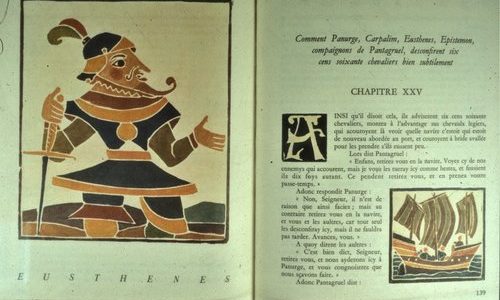
A page from Francois Rabelai’s, Pantagruel, illustrated by Andre Derain
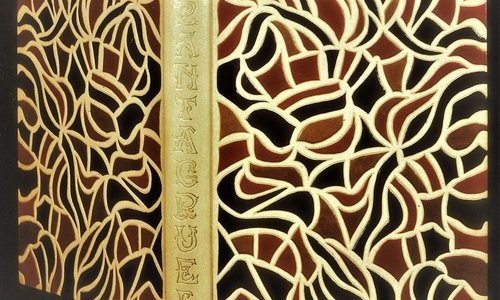
Another copy of Pantagruel with recessed colored shapes onlaid onto a white calfskin binding.
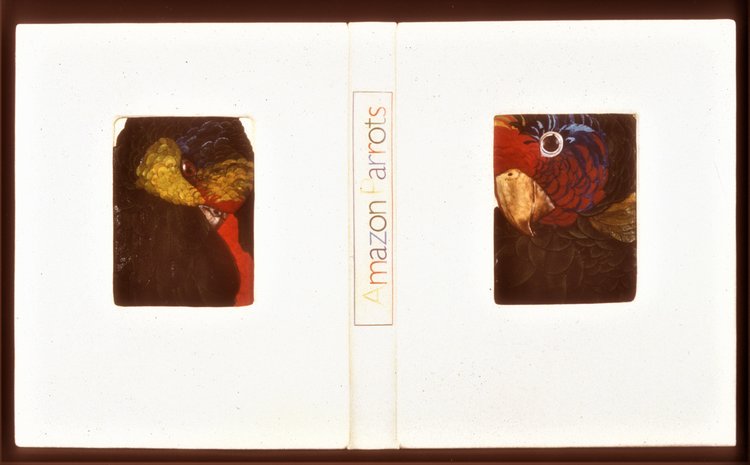
AMAZON PARROTS, ROSEMARY LOW, ILLUSTRATED BY ELIZABETH BUTTERWORTH, AMAZON PARROTS, 1983
Bound in alum tawed pig skin with bas-relief panels framed within the boards, one on the front cover and one on the back. The panels are portraits of parrots in the volume, enlarged, and created out of molded board covered in layers of multicolored leather feathers, shaped and textured. The eyes and beaks are painted vellum. The spine was tooled blind and then painted with variegated acrylic colors. The edges of the textblock were painted with colored pencils shifting color around the perimeter. The headbands were embroidered with variegated silk thread. 44 x 36 x 10 centimeters. Created 1984. In the collection of the New York Public Library.
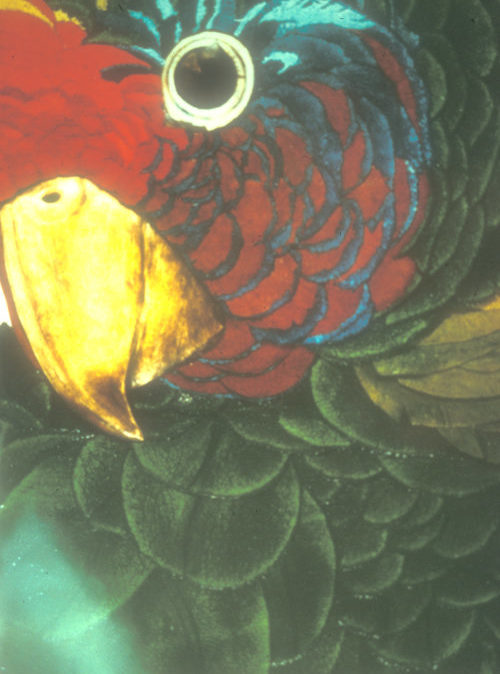
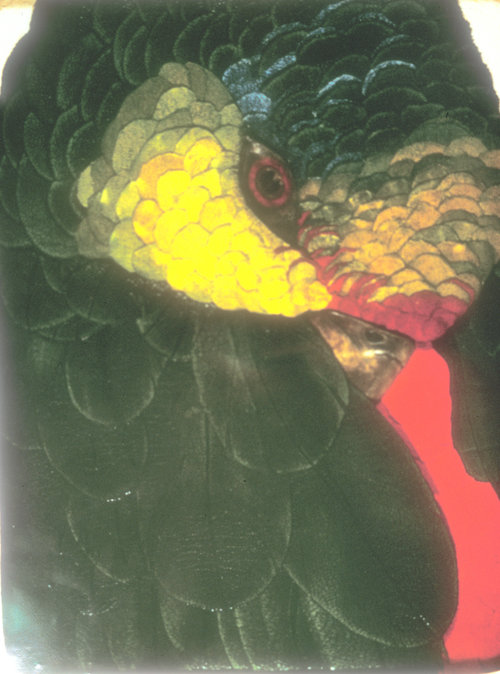
Close-up of the parrot panels
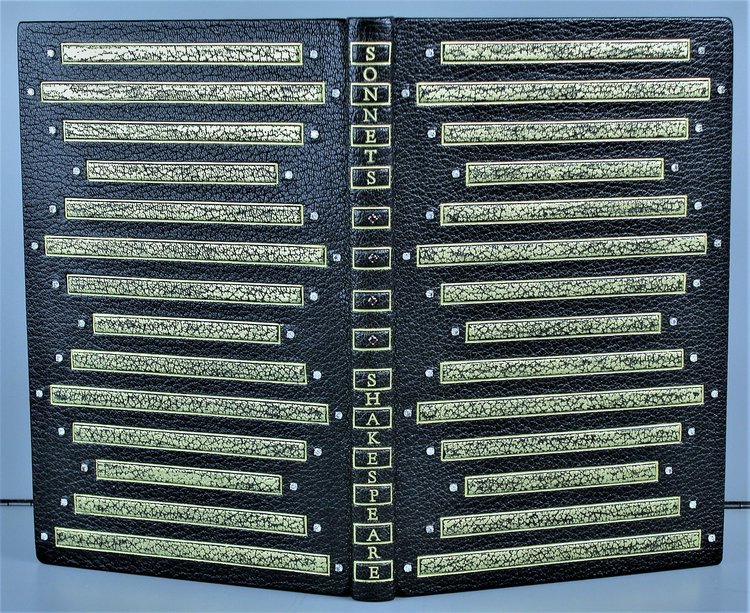
Jewel Binding of Shakespeare’s Sonnets, printed on vellum by the Petrarch press, bound in black goatskin and decorated with fourteen raised panels surface gilt on the front and back to represent. The covers and spine are adorned with 60 jewels; 56 diamonds and 4 rubies. Bound for the 60th anniversary of the Folger Shakespeare Library in 1992. In the collection of the Folger Shakespear Library, Washington DC.
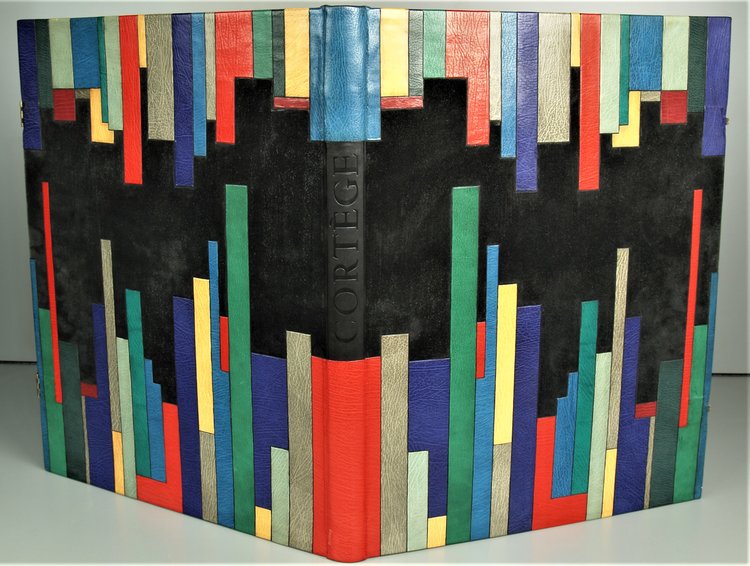


Cortège, by Pierre Lecuire, pourchoi illustrations by Lankoy, 1959
In the collection of The Mount Angel Abbey Library, bound in 1983
Bound in black suede with multicolored goatskin recessed onlays. The design is based upon illustrations suggesting banners one would see in a procession or parade. The binding recreates a 15th century “box binding” covering the edges of the text-block.




Règnes, by Pierre Lecuire, wih embossed illustrations by Ѐtienne Hajdu
Bound in white alum tawed goatskin. The design is based upon one of the images in the volume. The volume consists of three layers built-up to create the raised positive and negative design on the front and back boards. The design is reversed on the doublures. The negative spaces are inlaid with balck calfskin. To support the weight of the boards, leather covered brass stilts were incorporated. The covers are held closed with leather covered clasps
Bound in 1987

Moby Dick, by Herman Melville, The Arion Press, 1979, illustrated by Barry Moser. Bound in 1980, now at the Bridwell Library collection at SMU, Dallas Texas

Bound in white alum tawed pigskin embossed with a design carved into cherry wood panels, creating the impression Ishmel thought when he first saw the white whale, “ a scared and streaked white mountain”

A second copy of Moby Dick, bound with an alum tawed goatskin spine and walnut veneer boards, with an inlaid 18 karate gold bezel framed ivory scrimshaw reproducing the printed title page.




The Holy Bible, printed by the Pennyroyal Caxton Press 1999, designed and illustrated by Barry Moser.
The two-volume edition was bound in black Cape Morocco goatskin. Volume one depicts the creation of the universe at the moment of the “big bang”. Gold tooled lines radiate from a bold cluster of gold, amidst this background, gold and diamond stars are mounted into 18 carat gold bezels. Volume two depicts the Star of Nativity. A one carat diamond with three gold beams radiate toward the blind tooled landscape of Bethlehem.
Bound in 2006 now in the collection of Elizabeth Medaglia